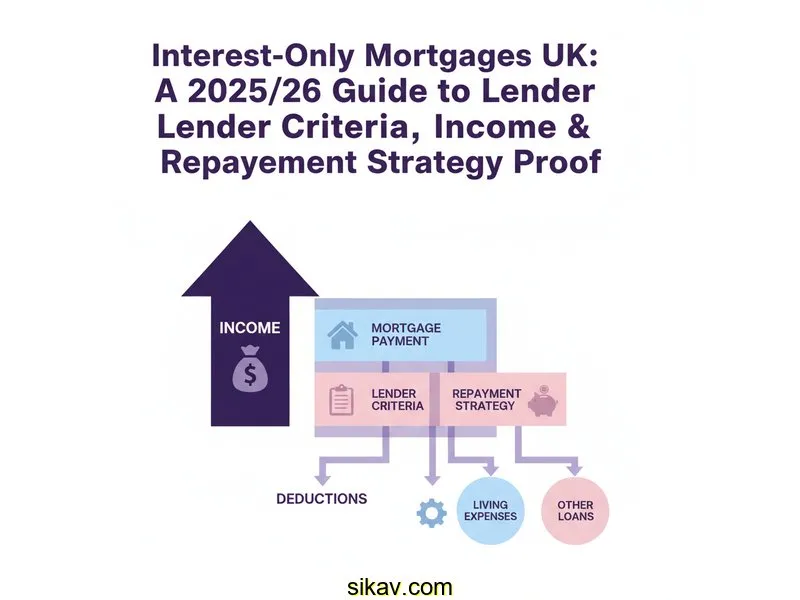
Picture this: you're exploring mortgage options for a new home purchase or a remortgage. You see 'interest-only' products advertised with temptingly low monthly payments. It seems like a great way to manage cash flow. Yet, when you speak to a broker, you're often met with a sharp intake of breath, followed by a string of questions about your income, assets, and "credible repayment strategy."
If you've felt this whiplash, you're not alone. The world of interest-only mortgages has changed dramatically in the last decade. Once common, they are now a niche product reserved for a specific type of borrower. Getting one isn't about simply having a good credit score; it's about proving to the lender, with cold, hard evidence, exactly how you will pay back the entire capital loan at the end of the term.
This guide, written from my perspective as a financial researcher at FinTools UK, aims to demystify the process. We'll explore the strict criteria, the income and LTV (Loan-to-Value) hurdles, and what lenders *really* mean when they ask for a "credible repayment strategy."
Key Takeaways
- A Niche Product: The number of outstanding interest-only mortgages in the UK fell by over 76%, from 3.2 million in 2012 to 754,000 by the end of 2023 (UK Finance, 2024). This reflects incredibly tight new lending standards.
- High Hurdles: Most lenders now require high minimum incomes (often £75,000-£100,000+ for a sole applicant) and a low LTV (typically a 50% deposit, or 50% equity).
- The "Credible Strategy" is Key: You must provide documentary proof of a separate, viable financial plan (like a stocks & shares ISA, pension, or second property) that will clear the entire capital loan.
- Sale of Property is Limited: Using the sale of your *main home* as a repayment plan is heavily restricted and often only available to older borrowers with significant equity (e.g., over 55s) or on a part-and-part basis.
- Disclaimer: This article provides informational guidance on lender criteria as of the 2025/26 tax year. It is not financial advice. Interest-only mortgages carry significant risks, and you should always consult a qualified, whole-of-market mortgage advisor to discuss your personal situation.
Why Are Interest-Only Mortgages So Hard to Get?
To understand today's rules, we have to look back. Before the 2008 financial crisis, interest-only mortgages were handed out far more freely. Many were given with no clear repayment plan, with borrowers simply *hoping* the property's value would rise enough to cover the debt when they sold. When the market crashed, millions were left in negative equity, owing the full loan amount but with no way to pay it.
This led to the "interest-only time bomb" (a topic we've covered in other articles) and a major regulatory crackdown. The Financial Conduct Authority (FCA) introduced much stricter rules in 2012, forcing lenders to be responsible. Under the FCA's Mortgage Conduct of Business (MCOB) rules, a lender *must* assess that the borrower has a "credible repayment strategy" in place.
Think of it this way: a pre-2008 interest-only mortgage was like a "borrow now, figure it out later" arrangement. The post-2012 version is like a highly secured loan. The lender needs to see, inspect, and approve your "figure it out later" plan *before* they give you a single penny. Your monthly payments only cover the interest, not the debt itself, so your repayment plan is the *only* thing that protects both you and the lender from default.
The Three Main Hurdles to Qualification
Qualifying for an interest-only mortgage in 2025/26 generally means clearing three significant hurdles. Failing even one will almost certainly mean your application is declined.
1. The Income Hurdle
This is often the first barrier. Lenders view these products as higher risk, so they restrict them to high earners. While criteria vary, it's common to see:
- Sole Applicant Minimum: £75,000 to £100,000+ per year.
- Joint Applicant Minimum: £100,000 to £150,000+ per year.
If your household income is below this, the vast majority of lenders will not even consider you for a full interest-only mortgage. They may, however, consider a "part-and-part" mortgage (where some of the loan is interest-only and some is repayment).
2. The LTV (Loan-to-Value) Hurdle
Forget the 5% or 10% deposits associated with first-time buyer repayment mortgages. For interest-only, lenders want significant "skin in the game." This minimises their risk if you default and they need to repossess the property.
- Maximum LTV: Typically 50% to 75%.
- The Reality: The most competitive products are often reserved for those with a 50% LTV or lower (i.e., a 50% deposit or 50% equity).
This requirement alone excludes most first-time buyers and those with smaller deposits.
3. The Repayment Strategy Hurdle
This is the most complex part of the application. You can't just *say* you'll save money. You must provide documentary proof of a plan that is "credible," "trackable," and "sufficient" to cover the entire loan capital.
Your repayment strategy is like a separate "sinking fund" for your mortgage. The lender needs to see that you are *actually* paying into it and that its projected growth (which they will often discount heavily) is on track to cover the full loan amount. Let's explore what this looks like in practice.
Repayment Strategies: What Lenders Will (and Won't) Accept
Here is a breakdown of the most common repayment strategies and the level of scrutiny you can expect from a lender. This is where many applications fall apart.
| Repayment Strategy | What It Is | Lender's View (Credibility) | Typical Required Proof |
|---|---|---|---|
| Stocks & Shares ISA / GIA | Using your existing or future investments in an ISA or General Investment Account. | High (if existing) / Medium (if future) | - 12-24 months of statements showing a lump sum and/or regular contributions. - Lenders will 'stress test' the fund. They may only accept 50-75% of the current value to account for market volatility. |
| Pension Pot (25% Tax-Free) | Using the 25% tax-free lump sum from your personal or workplace pension(s) upon retirement. | Medium to High | - Recent pension statements (within 6-12 months). - Lenders will only count 25% of the *projected* value, and they will apply their own conservative growth estimates. You must be old enough to access the pension before the mortgage term ends. |
| Sale of Other Property | Selling a second home or a Buy-to-Let property to pay off the mortgage on your main residence. | High (with caveats) | - Proof of ownership (Land Registry title). - A recent valuation for the second property. - An existing mortgage statement for that property. The lender will only accept the *verified equity* (current value minus outstanding mortgage). |
| Sale of Main Residence | Selling the house you are borrowing against to pay off the loan. | Very Low (Highly Restricted) | - Generally not accepted for standard residential mortgages. - Some lenders offer it for "Retirement Interest-Only" (RIO) mortgages or to borrowers over 55/60 with vast amounts of equity (e.g., 60%+). It's not a viable strategy for most working-age borrowers. |
| Endowment Policy | A (now rare) savings plan from an insurance company designed to pay off a mortgage. | High (if existing) | - The original policy documents. - A recent statement from the provider showing the 'on-track' or 'projected' maturity value. |
| "Future Savings" (Cash) | A plan to simply save cash in a bank account each month. | Very Low (Almost Never Accepted) | - Lenders will not accept this. The risk of inflation eroding the savings and the temptation for the borrower to spend the cash is considered far too high. You must use a recognised investment vehicle.
Common Questions About Interest-Only Mortgages
Based on questions I've seen across UK personal finance forums, here are the answers to the most common points of confusion.
What does a 'credible repayment strategy' actually mean to a lender in 2025?
It means a plan that is tangible, trackable, and robust. A "tangible" plan uses a recognised financial product like an ISA, pension, or another property. "Trackable" means the lender can ask for statements to see that the plan is still in place and on track. "Robust" means the lender is confident it will grow to the required amount, even after they apply their own 'haircut' or discount to your projections to account for market risk.
Do lenders still accept selling the property as a repayment strategy?
For your *main residence*, this is extremely rare. The FCA rules made this very difficult as it leaves the borrower needing to find a new home and pay off their mortgage at the same time. Some niche products for older borrowers (like RIO mortgages) or those with very high equity may allow it, but for a standard purchase, you should assume this is not an option. Selling a *second* property (like a BTL) is, however, widely accepted, provided you have sufficient equity in it.
What are the typical minimum income and equity requirements for an interest-only mortgage?
As a general baseline for 2025/26, you should assume a *minimum* sole income of £75,000-£100,000 (or £150,000+ joint) AND a *minimum* deposit or equity stake of 25%-50%. The very best deals are often reserved for those at 50% LTV (a 50% deposit). If you do not meet both of these high-level criteria, your application is unlikely to proceed.
Conclusion: Your Next Steps

An interest-only mortgage can be a powerful financial tool for the right person—often a high-earning individual with a sophisticated and well-established investment portfolio. For the vast majority of UK borrowers, however, the strict criteria mean a traditional repayment or part-and-part mortgage is the more realistic and accessible path to homeownership.
If you do meet the high income and LTV hurdles, your next step is to gather meticulous documentation for your repayment strategy. Get 24 months of statements for your ISAs, download your latest pension projections, and get a formal valuation for any other properties you own. This is the evidence you will need to pass the lender's scrutiny. Given the complexity and the high variation between lenders, this is one area where the guidance of an independent, whole-of-market mortgage advisor is not just helpful, but essential.

